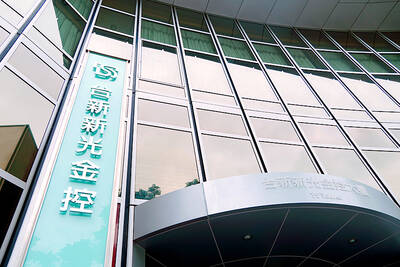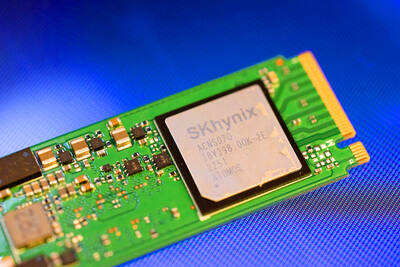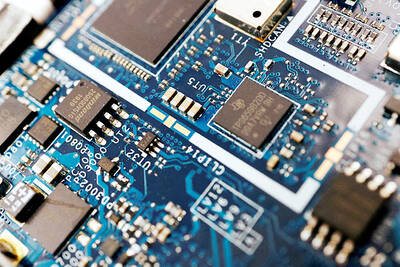Wrong-footed by rocketing consumer demand, Asian technology suppliers are scrambling to expand capacity before inventories run dry of everything from semiconductors to flat-panel screens.
Asian components makers, betting on a much longer economic downturn, last year ran down their stockpiles to “very unhealthy levels,” said Nancy Liu (劉美君), an analyst at the Industrial Technology Research Institute.
But demand worldwide for gadgetry ranging from computers to smartphones and liquid-crystal displays is zooming ahead, even if the West’s retail sales as a whole are still sluggish. And China is a boom market all by itself.
Jin Sung-hye, an analyst with South Korea’s Shinhan Investment Corp, said Asian component makers were now rushing to ramp up production after failing to forecast the consumer recovery.
“However, higher component prices will not lead to a drastic increase in PC prices, as makers are under pressure to produce upgraded models,” she said.
Makers of computers and consumer electronics could instead see their profit margins squeezed, given cut-throat industry competition with consumers used to ever-falling prices on the high street.
And consumers themselves might have to get used to delays in procuring the latest must-have gadgets, a problem that has afflicted Apple’s iPhone as Taiwanese chip suppliers struggle to keep up.
Component shortages will linger, with analysts saying it typically takes 15 months from the time a manufacturer decides to boost capacity until production actually picks up.
“Shortages are expected to continue throughout this year and possibly into early next year if the global economy maintains the current pace of recovery,” Jin said.
US giant Intel, the world’s biggest chipmaker, last week reported its net profit soared nearly nine-fold to US$2.3 billion in the last quarter of last year.
Its booming sales came as industry tracker IDC reported that US computer shipments topped 20 million in the fourth quarter, a record figure, while global PC shipments jumped 15.2 percent year-on-year.
IDC identified two key factors — abundant deals on low-priced netbook computers and pent-up demand as consumers upgraded their PCs after the financial crisis.
Industry shortages mean the semiconductors needed for an average computer are likely to be 2.8 percent more expensive this year than last, marking the first rise since 2004, analyst firm Gartner said.
The average selling price for 1 gigabyte of DRAM, or computer memory, will still decline by eight percent this year. But that compares with much steeper falls of 27 percent last year and 53 percent in 2008, Gartner said.
“If we look at how bad it was in the first quarter of last year, no one could have predicted that the economy would recover this fast,” Taiwan-based Gartner analyst Ben Lee (李輔邦) said.
“There was financial turbulence, and companies went bankrupt,” he said.
“This has changed with government stimulus plans plus a loose monetary situation. Money is flooding into the market. Everyone can borrow,” he said.
The Chinese government implemented a stimulus spree worth US$586 billion and consumers in the world’s third-largest economy have played a major role in stoking demand, observers said.
“The fast recovery in the Chinese market appears to be the main reason” for the global technology boom, Jin said.
Taiwan’s Innolux Display Corp (群創光電) is one technology company being forced into a drastic reappraisal of its plans as it battles to keep up with the demand. The firm recently announced a merger with rival Chi Mei Optoelectronics Corp (奇美電子) as it vies to take on the big Japanese and South Korean suppliers of flat-panel displays.
The deal was originally expected to be completed in May, but has now been hastily brought forward to March.

On Tuesday, US President Donald Trump weighed in on a pressing national issue: The rebranding of a restaurant chain. Last week, Cracker Barrel, a Tennessee company whose nationwide locations lean heavily on a cozy, old-timey aesthetic — “rocking chairs on the porch, a warm fire in the hearth, peg games on the table” — announced it was updating its logo. Uncle Herschel, the man who once appeared next to the letters with a barrel, was gone. It sparked ire on the right, with Donald Trump Jr leading a charge against the rebranding: “WTF is wrong with Cracker Barrel?!” Later, Trump Sr weighed

HEADWINDS: Upfront investment is unavoidable in the merger, but cost savings would materialize over time, TS Financial Holding Co president Welch Lin said TS Financial Holding Co (台新新光金控) said it would take about two years before the benefits of its merger with Shin Kong Financial Holding Co (新光金控) become evident, as the group prioritizes the consolidation of its major subsidiaries. “The group’s priority is to complete the consolidation of different subsidiaries,” Welch Lin (林維俊), president of the nation’s fourth-largest financial conglomerate by assets, told reporters during its first earnings briefing since the merger took effect on July 24. The asset management units are scheduled to merge in November, followed by life insurance in January next year and securities operations in April, Lin said. Banking integration,

LOOPHOLES: The move is to end a break that was aiding foreign producers without any similar benefit for US manufacturers, the US Department of Commerce said US President Donald Trump’s administration would make it harder for Samsung Electronics Co and SK Hynix Inc to ship critical equipment to their chipmaking operations in China, dealing a potential blow to the companies’ production in the world’s largest semiconductor market. The US Department of Commerce in a notice published on Friday said that it was revoking waivers for Samsung and SK Hynix to use US technologies in their Chinese operations. The companies had been operating in China under regulations that allow them to import chipmaking equipment without applying for a new license each time. The move would revise what is known

Artificial intelligence (AI) chip designer Cambricon Technologies Corp (寒武紀科技) plunged almost 9 percent after warning investors about a doubling in its share price over just a month, a record gain that helped fuel a US$1 trillion Chinese market rally. Cambricon triggered the selloff with a Thursday filing in which it dispelled talk about nonexistent products in the pipeline, reminded investors it labors under US sanctions, and stressed the difficulties of ascending the technology ladder. The Shanghai-listed company’s stock dived by the most since April in early yesterday trading, while the market stood largely unchanged. The litany of warnings underscores growing scrutiny of